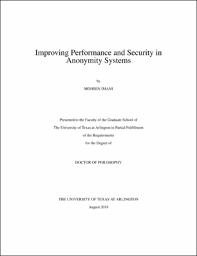
ATTENTION: The works hosted here are being migrated to a new repository that will consolidate resources, improve discoverability, and better show UTA's research impact on the global community. We will update authors as the migration progresses. Please see MavMatrix for more information.
Show simple item record
| dc.creator | Imani, Mohsen | |
| dc.date.accessioned | 2019-08-29T20:42:29Z | |
| dc.date.available | 2019-08-29T20:42:29Z | |
| dc.date.created | 2018-08 | |
| dc.date.issued | 2018-09-06 | |
| dc.date.submitted | August 2018 | |
| dc.identifier.uri | http://hdl.handle.net/10106/28645 | |
| dc.description.abstract | Tor is an anonymity network that provides online privacy for the Internet users. Tor hides the user's traffic among the others' traffic. The more users Tor attracts, the stronger anonymity it provides. Unfortunately, users of the Tor anonymity system suffer from less-than-ideal performance, in part because circuit building and selection processes are not tuned for speed. Moreover, there are some attacks like guard fingerprinting and website fingerprinting attacks that try to profile or de-anonymize the Tor users. In this dissertation, we propose methods to address both security and performance issues in Tor. We first examine the process of selecting among pre-built circuits and the process of selecting the path of relays for use in building new circuits to improve performance while maintaining anonymity. We also propose a method to improve the mechanism of picking guards in Tor. The guard selection mechanism in Tor suffers from security problems like guard fingerprinting and from performance issues. To address this problem, we propose a new method for forming guard sets based on Internet location. We construct a hierarchy that keeps clients and guards together more reliably and prevents guards from easily joining arbitrary guard sets. This approach also has the advantage of confining an attacker with access to limited locations on the Internet to a small number of guard sets. Tor is also known to be vulnerable to the traffic analysis attacks like Website Fingerprinting (WF) attacks. In WF attacks, the adversary attempts to identify the websites visited by the user. We also propose a method using adversarial examples to decrease the accuracy rate of the WF attack. We generate adversarial traces to cause misclassification in the WF attackers. We show that if the WF attacker trains its classifier on the adversarial traces, they are not effective WF defenses. We propose a method to solve this problem, and we show that our method can drop the WF attacker's accuracy from 98% to 60% with 47% bandwidth overhead. | |
| dc.format.mimetype | application/pdf | |
| dc.subject | Anonymity | |
| dc.subject | Privacy | |
| dc.subject | Tor network | |
| dc.subject | Security | |
| dc.title | Improving Performance and Security in Anonymity Systems | |
| dc.type | Thesis | |
| dc.contributor.committeeMember | Wright, Matthew | |
| dc.contributor.committeeMember | Zaruba, Gergely | |
| dc.contributor.committeeMember | Huber, Manfred | |
| dc.contributor.committeeMember | Kamangar, Farhad | |
| dc.degree.department | Computer Science and Engineering | |
| dc.degree.name | Doctor of Philosophy in Computer Science | |
| dc.date.updated | 2019-08-29T20:42:29Z | |
| thesis.degree.department | Computer Science and Engineering | |
| thesis.degree.grantor | The University of Texas at Arlington | |
| thesis.degree.level | Doctoral | |
| thesis.degree.name | Doctor of Philosophy in Computer Science | |
| dc.type.material | text | |
Files in this item
- Name:
- IMANI-DISSERTATION-2018.pdf
- Size:
- 1.417Mb
- Format:
- PDF
This item appears in the following Collection(s)
Show simple item record


